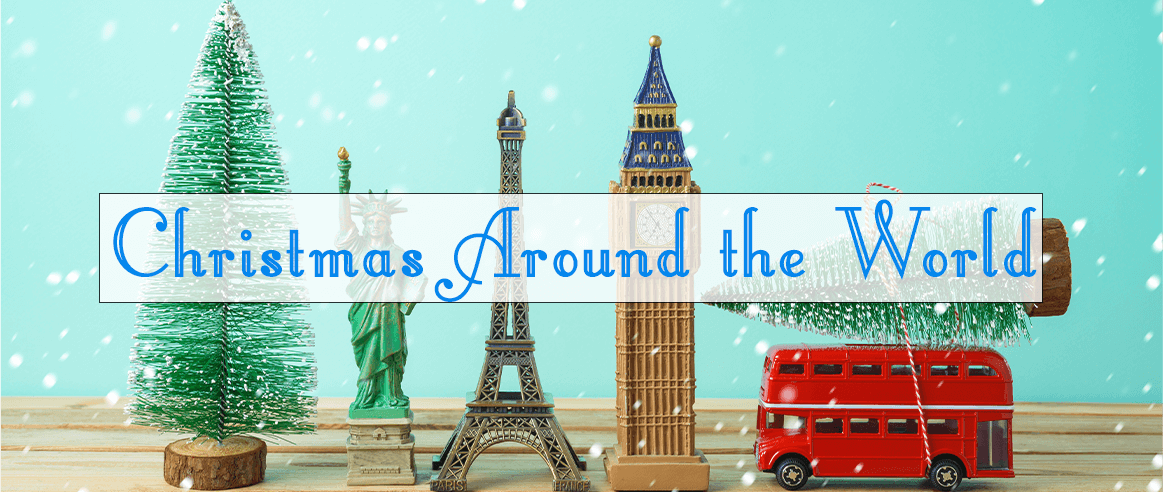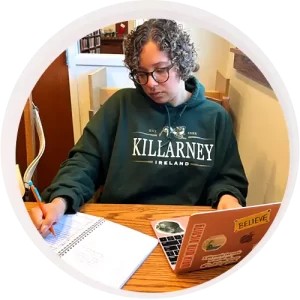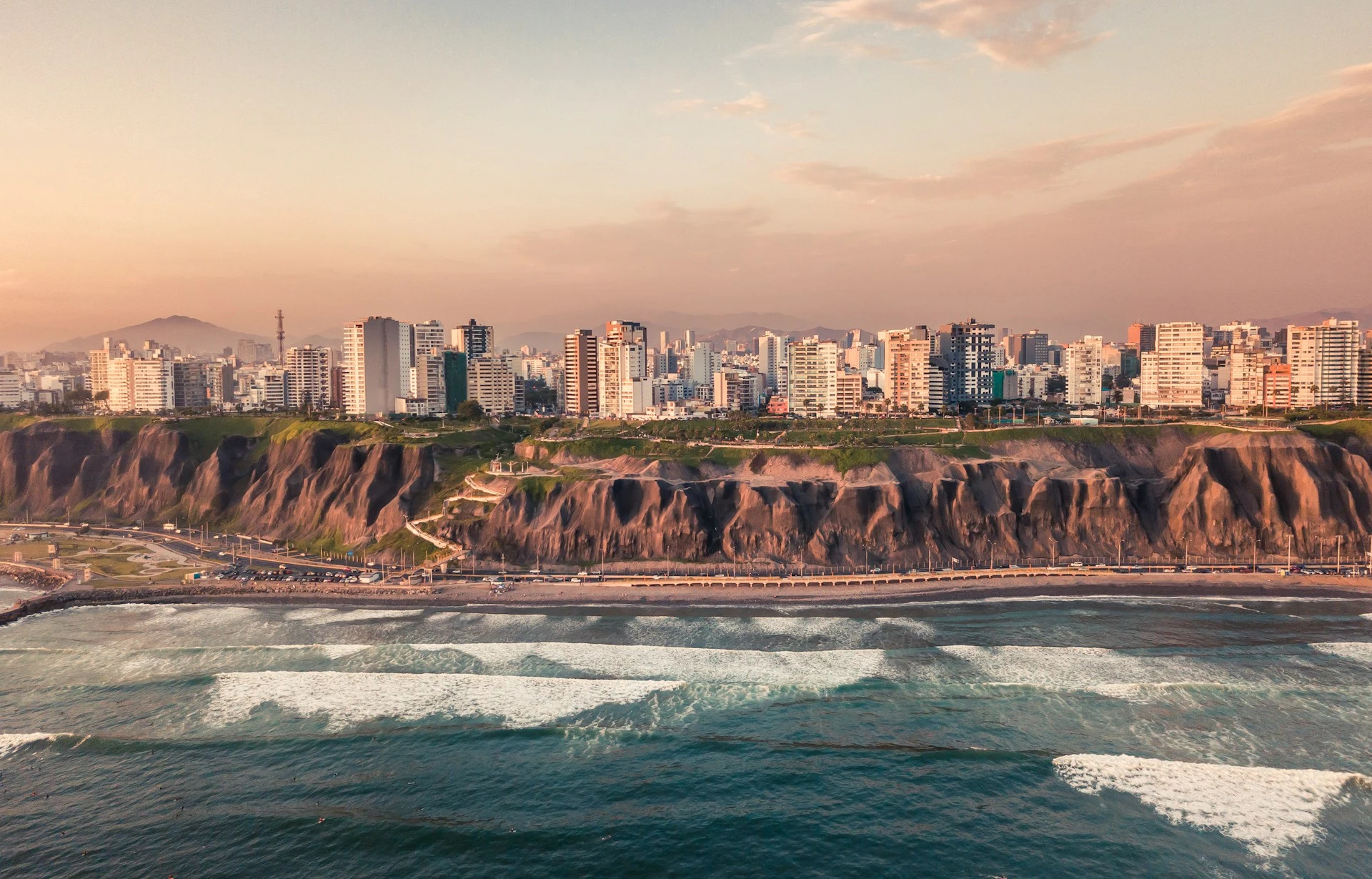Written by Jaden Parker
It’s always so interesting to learn new things. So, I took the time to find out how people all over the world celebrate Christmas. Obviously Christmas isn’t the only holiday celebrated during December, so I’ll be getting to that in part 3 of this little series. Either way, here is how Christmas is celebrated in some countries, letters A through G!
Argentina
Many Argentinians are Catholic, so they celebrate Christmas and Advent. The 8th of December is the feast of the Immaculate Conception, and most have their Christmas trees decorated by then. Most Argentinians prefer artificial trees over real ones, and some even put cotton balls on the tree to make it look like snow. Their Nativity scene is called pesebre, and it is always displayed near the tree.
The main Christmas meal is eaten around 10pm on Christmas Eve and can include vitel toné (veal with an anchovy and tuna sauce) or torre de panqueques (a “cake” of several layers of tortillas with alternating ham, cheese, lettuce, and tomato). They also enjoy desserts like mantecol and turron, which are both types of nougat.
Also on Christmas Eve, people float globos, or Chinese lanterns, in the sky. People toast to the start of Christmas day with lots of fireworks at midnight. People either go to midnight Mass, open their presents, or go to night parties. Children can hope to receive gifts from Papá Noel (Father Christmas), El Niño Diós (the Baby Jesus), or Reyes Magos (The Three Wise Men).
Australia
Christmas is a summer holiday for Australians, so a lot of volunteer bush fire fighters have to work hard saving people all over Australia. A street in Sydney has a coordinated street display that raises money for charity. Some Australians decorate with a native Australian tree that has cream-colored flowers and small green leaves. By the week of Christmas, the flowers turn red.
Famous Australian singers help lead carol services in varying cities that are broadcasted on TV. Since a lot of carols reference snow and winter, Australians have changed the words or created new carols! Children leave cake and a non-alcoholic beer for Santa—because Santa can’t drink and drive.
On Boxing Day, a Yacht race from Sydney to Hobart is held along with the Boxing Day Cricket Test Match at the Melbourne Cricket Ground, and people living in the outback send greetings to their families over the radio! The main Christmas meal is usually at lunch with cold food for Christmas dinner. They top all that off with their traditional Christmas pudding and/or pavlova.
Belgium
Children receive a visit from Saint Nicholas or Sinterklaas on December 5th and 6th, which is St. Nicholas’ Eve and Day respectively. In exchange for a carrot for his horse, Sinterklaas fills their shoes placed in front of the fireplace with goodies. They may also leave something for Chimney Peter, Sinterklaas’ assistant. If children have been bad, they believe that Peter will put them in a sack and take them to Spain! Families also leave chocolate, tangerines, gingerbread, and mokjes, which are cookies shaped like letters.
Christmas is more of a religious celebration, so a special meal is eaten on Christmas Eve. They have an apéritif, appetizers, a seafood starter, and a stuffed turkey. The dessert is a chocolate Christmas Log that is a sponge roll layered with cream and covered with a chocolate butter cream. Before Christmas, people go to Christmas Markets to get decor, presents, and food. Gifts are opened on Christmas Eve.
Brazil
A lot of Brazilian Christmas traditions come from Portugal due to Portugal ruling Brazil for some time. Presépio, or Nativity Scenes, are set up in front of churches and homes throughout December. The Christmas plays called The Shepherds, or Os Pastores, that are performed around the country always have a shepherdess and a woman character who tries to steal baby Jesus!
Most people go to Missa do Galo, which is an hour-long Midnight Mass. After mass, they have giant firework displays. Santa is called Papai Noel and Bom Velhinho (Good Old Man), and many people go to the beach since it’s summer for them. In December, Brazilians commonly receive a “13th salary;” they get twice their normal pay that month!
Some children leave a sock by their window for Papai Noel to exchange for a present. A lot of people do a month-long Secret Santa and reveal who they had on Christmas Day. For Christmas Eve dinner at 10pm, Brazilians eat anything from pork and turkey to rice cooked with raisins and farofa, which is seasoned manioc flour.
Canada
Due to the number of cultures residing in Canada, there are many different Christmas traditions celebrated there. Gifts overall are typically opened on Christmas Eve. Going skating, skiing, or sledding is also quite common for people to do across the country. The Santa Claus Parade in Toronto is one of the world’s oldest and largest Santa parades; it started in 1913.
Christmas meals usually include roast turkey and vegetables for dinner and plum pudding and mincemeat tarts for dessert. Some people love Christmas crackers, too. Cookie-baking parties also happen where you bring a cookie recipe, bake it, then exchange the cookies with family members so everyone goes home with a bunch of sweets for the holiday season.
Regionally, northern Canada has a Taffy Pull to honor Saint Catherine. She’s the patron saint of single women, so this is a party for singles to mingle. In Nova Scotia, they traditionally give their biggest and best fir tree to Boston in America to honor their assistance during the Halifax Explosion. They also have a tradition called Belsnickeling where people go from home-to-home dressed up as a funny Santa until someone guesses who they are. This tradition was brought to the area by German immigrants in 1751!
Newfoundland also has some of its own traditions. Mummering or Jannying is where people dress up in costumes and approach peoples’ homes asking in an odd voice “Any mummers ‘loud in?” They get some cake and something to drink before moving onto the next house. If the host can’t guess who the Mummers are, they have to join them! The tradition has been banned in some places, however, as people used it as an excuse to beg for things. Labrador City has a Christmas Light-Up Contest, and some people have giant ice sculptures in their front yards for it!
Denmark
Most all Danish people who celebrate Christmas have heard of a Kalenderlys, Pakkekalendar, and the Julekalendar. The Kalenderlys is an Advent candle, and the Pakkekalendar is the paper calendar with the little gifts in it. Julekalendar, or Christmas calendar, is actually a 24-episode TV special that airs on both of the main Danish TV channels. The channels that have produced it since 1962 send out paper advent calendars for people to follow along with. Profits from the paper calendar sales go to charities helping children.
The Christmas sermon is held at 4pm on Christmas Eve, after which people take part in the tradition of celebrating animals by walking in the words or park to feed them. Like a lot of countries in this area, the 1958 Disney special “From All of Us to All of You” is shown on Christmas Eve after the church service.
Christmas Eve is when they have their main big meal. It can include roast duck, goose, or pork as the main course. A lot of people have a Juleand, which is roast goose or duck stuffed with apples, prunes, and herbs and covered with a vermouth-based gravy. It’s served with a cranberry sauce, sweet potatoes, cabbage, and beets. Dessert is a rice pudding called ris á la mande, which has all but one almond chopped up inside it. Whoever finds the whole almond get the Mandelgave, which means “almond present” and is traditionally a marzipan pig, some sort of sweet, or a toy.
Christmas trees are decorated with silver “fairy hair” to make it sparkle, and people open their presents after dinner and lighting of the tree. Presents are brought by Julemanden, or “Christmas Man,” who lives in Greenland and is helped by his elves called nisser.
Dominican Republic
Since there are no fir trees in the Dominican Republic, they decorate Charamicos, which are dry tree branches that come in a bunch of different shapes and colors. They’re typically painted white to look like snow. Large nativity scenes, or Nacimiento, are commonly seen in towns and cities. There is a tradition of parties that move from house to house and gather more and more people called Aguinaldos.
They do a secret Santa game called Un Angelito, which means “Little Angel,” and some people get Double Sueldo, or a Christmas bonus, in December. Midnight Mass is called Las Misa del Gallo, meaning the Mass of the Rooster. An older tradition was to not give material things but spend quality time with loved ones instead. Nevertheless, children can expect to receive presents on January 5th (Epiphany Eve) that are brought by the Three Kings. They leave straw for the Kings’ camels and sweets for the Kings. Some areas believe that it is La Vieja Belen (the old lady of Bethlehem) who brings them their presents, too.
As far as food goes, La Noche Buena is when they have their main meal consisting of cerdo asado (roast pork), potato salad, salsa, tamales cooked in banana leaves (pasteles en hojas), and a long bread called Pan Telera. Like Argentina, they have turrón as a dessert, along with jalea de batata. They also have a popular Christmas drink called Té de Jengibre, which is a warm drink made from ginger root and cinnamon.
Finland
Finnish fishermen make sure to return to the harbors by St. Thomas’ Day, and all houses are cleaned from top to bottom to prepare for Christmas Eve, Christmas Day, and Boxing Day. On the day before or of Christmas Eve, people get their Christmas trees, and haggling over the price is expected. Farmers celebrate the animals by hanging wheat, nuts, and suet pieces on trees for the birds.
Santa is Joulupukki, which means “Christmas Goat.” Traditionally, there was a Yule Goat who scared people into giving it presents, but it slowly transformed into a human who now gives gifts. Joulupukki lives in northern Finland where there is the tourist park “Christmas Land” near his house. Joulupukki personally visits homes and asks if children are living there. All the children must loudly reply, then the whole family watches them open their presents.
The radio and TV broadcast “Peace of Christmas” from the City Mayor of Turku in the middle of the day on Christmas Eve, and “From All of Us to All of You” is shown on the TV in the afternoon. Since it gets dark around 3 p.m., family members take lanterns to the graves of their loved ones, lighting up the cemetery with the lanterns in the snow. Christmas Day is more lowkey and relaxed, but skating and skiing are common on Boxing Day.
The Christmas meal traditionally had lutefisk as a starter, but not many people eat it anymore. The main course is a leg of pork with mashed potatoes. Both are baked in birch-bark boxes in the oven! They have a lot of casseroles, cured salmon, and rice pudding for dessert. The pudding has spiced plum jam with an almond hidden inside it. Whoever finds the almond has luck for the new year.
France
In France, Yule logs of cherry wood are burned. In olden traditions, the log was sprinkled with red wine to make it smell good when it was burned. Throughout the night, candles and the log burn with food and drink left out for baby Jesus and Mary. Santa, or Père Noël, is accompanied by a sidekick in eastern France. Le Pere Fouettard is dressed all in black and is similar to Belgium’s Chimney Peter.
The Nativity scene is a huge part of French Christmas traditions. The scene is actually a crib with clay figures inside it. Some fairs, like the giant Christmas market in Strasbourg, sell the Nativity figures. The scene includes a Butcher, Baker, Policeman, and Priest.
Réveillon is the main meal on Christmas Eve or right after Midnight Mass. It can consist of many things like roast goose, oysters, foie gras, lobster, venison, and cheese. Dessert is a log-shaped cake made of chocolate sponge called bûche de Noël. The French also celebrate the Épiphanie on January 6th and eat Galette des Rois. It’s a flat cake made of puff pastry and almond cream. A fève bean used to be baked inside it, but now it is a little figure or crown. Whoever finds it wears the paper crown and is supposed to bring the Galette des Rois the next year!
Germany
Germany’s biggest traditions during this season are for Advent. They have fir wreaths with 24 decorated bags hanging on it to celebrate the holiday. The very first Christmas trees used were during the late Middle Ages. If there are children in the home, the tree is secretly decorated by the mother of the family. Traditionally, the tree is brought inside on Christmas Eve. On the evening of Christmas Eve, the family gathers around the tree, reads the Bible, and sings Christmas songs. Also, Scherenschnitte is a tradition of cutting paper into Christmas shapes and putting different colored paper behind it to make it look like stained glass.
Children put their shoes by the door on the 5th of December for der Nikolaus to fill on the 6th. If he knocks on the door, children must entertain him with a song, playing of instruments, or telling a story before he gives them their presents. Some areas of Germany believe in Krampus, a scary horned monster who punishes bad children. Other parts have Schwarzer Peter (Black Peter) who has a whip or Belsnickel, a man dressed entirely in fur. Santa, Weihnachstmann, can also bring presents for the children.
In southeastern Germany, kids ask das Christkind for presents by setting envelopes decorated with sugar to make it sparkly on their windowsill at the start of Advent. Das Christkind translates to “The Christ Child,” but it is not the baby Jesus. Instead, it’s a young girl who has “Christ-like qualities.” In Nuremberg, they choose a girl every year to be the Christkind in a parade. Das Christkind has a long white and gold dress, long blond curly hair, a gold crown, and occasionally angel wings. The young girl has 150 duties she must see to during the season. On the Friday before Advent, she opens the Christmas market, and she visits hospitals, old folk’s homes, children, and other cities throughout the holiday. She also does interviews for TV!
Some schools and small workplaces put presents into a room and pass them out until everyone has theirs. It is considered bad luck to find out who got you your gift. There is also a Catholic tradition of the Sternsinger where people carol for charity. Usually, it is four children with three dressed like wise men. They put a chalk signature on your door, and it’s bad luck to wash it off; you have to let it fade away naturally.
The Christmas markets, or Christkindlmarkt, are known for selling their famous German glass ornaments. However, people in Germany have never heard America’s legendary “Christmas Pickle.” Christmas meal staples are carp or goose and Stollen, which is fruit bread. On the 29th or 30th of December, the Four Hills Tournament starts in Oberstdorf. Also, everyone watches Germany’s most repeated television show, “Dinner for One,” on New Year’s Eve.
Greece
Keeping kallikantzaroi, or bad spirits, away from Christmas to January 6th is a huge deal for those who celebrate Christmas in Greece. The kallikantzaroi makes milk go bad and puts out peoples’ fires. Basil is hung over a shallow bowl of water and dipped in it daily by a family member in order to sprinkle the water in every room of the house. Keeping a fire burning through the twelve days and burning old shoes are also a way to scare off the spirits.
Boys sing kalanda songs (carols) and occasionally carry model boats decorated with gold-painted nuts with them. They play drums and triangles and can be rewarded with money and sweets if they perform well. As boats and ships are very important to Greek culture, a three masted sailing ship is set up by a Christmas tree in Aristotelous Square in Thessaloniki. Other large cities also have large boat displays.
The first Christmas tree in Greece was set up by King Otto by a large decorated boat in 1833. After Midnight Mass, people end their Advent fast with the Christmas meal. The meal can have lamb or pork, spinach pie, and cheese pie. Their desserts are Baklava, Kataifi, Theeples, melomakarona, and kourabiedes.
On St. Basil’s Day, Aghios Vassilis brings children presents for the new year. The Pothariko tradition occurs on this day. The “lucky” child, first-born of the family, or man of the house enters the house first for the year to bring luck to the household. They must step in with their right foot first. Some families break a pomegranate at the front door. Vasilopita is baked, which is a cake with a coin baked inside. The finder of the coin is lucky for the year. Traditionally, the slices are served first for Jesus, Mary, the poor, the house, and then to each member of the family starting with the oldest.
The Greek also celebrate the Epiphany on the 6th of January with men diving into really cold water to be the first to find the cross that’s been thrown in after being blessed by a priest. There are a lot of boat and ship blessings, music, and dancing.
Greenland
Everyone in the villages of Greenland receives a gift for Christmas. Traditional Christmas gifts were sledges, walrus tusks, and sealskin mittens. A lot of people wear their national costumes to Christmas Eve church services. Christmas trees are imported from Denmark and decorated with candles on the 23rd of December. Occasionally, families put kamiks, or sealskin boots, on the tree.
The sun never rises in the winter, so people put illuminated stars in the windows, a tradition that came from Christian missionaries of the Moravian church. On Christmas Night, the men look after the women, serving them food and coffee and stirring the pots of food. The Christmas meal has mattak, whale skin with a strip of blubber; kiviak, raw flesh of arctic birds that have decomposed inside sealskin; suaasat, soup; caribou; lamb; and fish. Desserts are berry or apple crisp and Christmas porridge. After everyone eats, they play games.
The people of Greenland believe that Santa has a rumored vacation home in the north in Spraglebugten. They also celebrate two New Year’s Eves! At 8 p.m. they celebrate Denmark’s new year and then again at midnight for their own.
Stay tuned for parts two and three of how other countries celebrate Christmas and make sure to check out the posting with links to all the daily articles!









